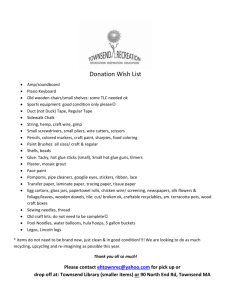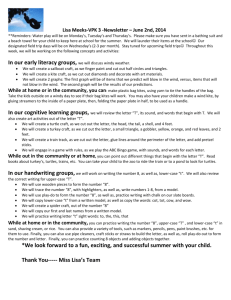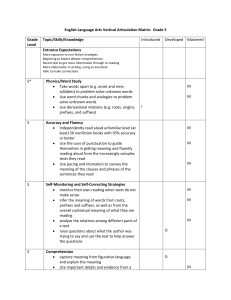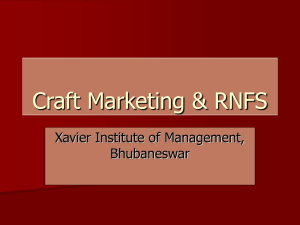Gr6-Lit Craft and Structure - LA-Curriculum
advertisement
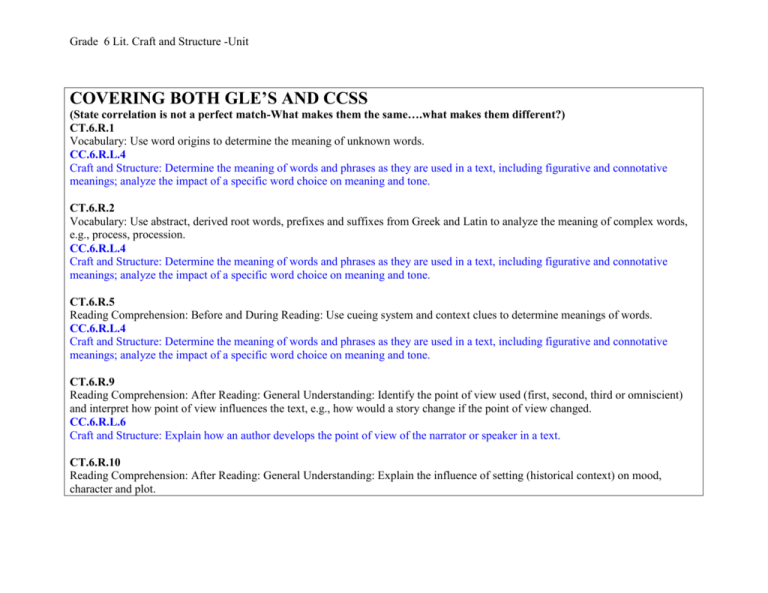
Grade 6 Lit. Craft and Structure -Unit COVERING BOTH GLE’S AND CCSS (State correlation is not a perfect match-What makes them the same….what makes them different?) CT.6.R.1 Vocabulary: Use word origins to determine the meaning of unknown words. CC.6.R.L.4 Craft and Structure: Determine the meaning of words and phrases as they are used in a text, including figurative and connotative meanings; analyze the impact of a specific word choice on meaning and tone. CT.6.R.2 Vocabulary: Use abstract, derived root words, prefixes and suffixes from Greek and Latin to analyze the meaning of complex words, e.g., process, procession. CC.6.R.L.4 Craft and Structure: Determine the meaning of words and phrases as they are used in a text, including figurative and connotative meanings; analyze the impact of a specific word choice on meaning and tone. CT.6.R.5 Reading Comprehension: Before and During Reading: Use cueing system and context clues to determine meanings of words. CC.6.R.L.4 Craft and Structure: Determine the meaning of words and phrases as they are used in a text, including figurative and connotative meanings; analyze the impact of a specific word choice on meaning and tone. CT.6.R.9 Reading Comprehension: After Reading: General Understanding: Identify the point of view used (first, second, third or omniscient) and interpret how point of view influences the text, e.g., how would a story change if the point of view changed. CC.6.R.L.6 Craft and Structure: Explain how an author develops the point of view of the narrator or speaker in a text. CT.6.R.10 Reading Comprehension: After Reading: General Understanding: Explain the influence of setting (historical context) on mood, character and plot. Grade 6 Lit. Craft and Structure -Unit CC.6.R.L.5 Craft and Structure: Analyze how a particular sentence, chapter, scene, or stanza fits into the overall structure of a text and contributes to the development of the theme, setting, or plot. CT.6.R.13 Reading Comprehension: After Reading: Developing an Interpretation: Explain the use of foreshadowing and parallel plots to convey meaning. CC.6.R.L.5 Craft and Structure: Analyze how a particular sentence, chapter, scene, or stanza fits into the overall structure of a text and contributes to the development of the theme, setting, or plot. CT.6.R.14 Reading Comprehension: After Reading: Developing an Interpretation: Explain the use of flashbacks to convey meaning. CC.6.R.L.5 Craft and Structure: Analyze how a particular sentence, chapter, scene, or stanza fits into the overall structure of a text and contributes to the development of the theme, setting, or plot. CT.6.R.15 Reading Comprehension: After Reading: Developing an Interpretation: Explain various subgenres of fiction based on their characteristics, e.g., science fiction, fantasy, myths, legends. CC.6.R.L.5 Craft and Structure: Analyze how a particular sentence, chapter, scene, or stanza fits into the overall structure of a text and contributes to the development of the theme, setting, or plot. Grade 6 Lit. Craft and Structure -Unit CT.6.R.19 Reading Comprehension: After Reading: Content and Structure: Explain the impact of literary devices on meaning, e.g., flashback, tone, bias, dialect, irony/satire, and use of fragments. CC.6.R.L.4 Craft and Structure: Determine the meaning of words and phrases as they are used in a text, including figurative and connotative meanings; analyze the impact of a specific word choice on meaning and tone. CC.6.R.L.5 Craft and Structure: Analyze how a particular sentence, chapter, scene, or stanza fits into the overall structure of a text and contributes to the development of the theme, setting, or plot. CT.6.R.20 Reading Comprehension: After Reading: Content and Structure: Evaluate the author's use of various techniques to influence readers' perspectives, e.g., appeal of characters in a graphic novels and picture books, logic and credibility of plots and settings, use of figurative language. CC.6.R.L.4 Craft and Structure: Determine the meaning of words and phrases as they are used in a text, including figurative and connotative meanings; analyze the impact of a specific word choice on meaning and tone. CC.6.R.L.5 Craft and Structure: Analyze how a particular sentence, chapter, scene, or stanza fits into the overall structure of a text and contributes to the development of the theme, setting, or plot. Media Integration N/A GLE’s but not CCSS CT.6.R.5 Reading Comprehension: Before and During Reading: Use cueing system and context clues to determine meanings of words. CT.6.R.19 Grade 6 Lit. Craft and Structure -Unit Reading Comprehension: After Reading: Content and Structure: Explain the impact of literary devices on meaning, e.g., flashback, tone, bias, dialect, irony/satire, and use of fragments. CT.6.R.20 Reading Comprehension: After Reading: Content and Structure: Evaluate the author's use of various techniques to influence readers' perspectives, e.g., appeal of characters in a graphic novels and picture books, logic and credibility of plots and settings, use of figurative language. CC.7.R.L.4 Craft and Structure: Determine the meaning of words and phrases as they are used in a text, including figurative and connotative meanings; analyze the impact of rhymes and other repetitions of sounds (e.g., alliteration) on a specific verse or stanza of a poem or section of a story or drama. This gle does not correlate to CCSS grade 3-8: CT 6.R.22 Draw a conclusion about how text might be useful to someone. CCSS but not GLE’s N/A


